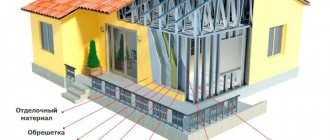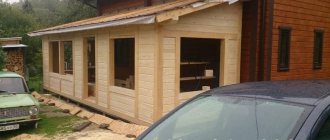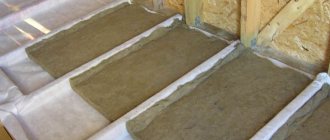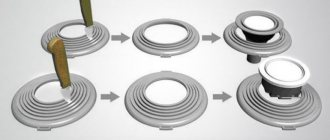To make life at the dacha comfortable, it is necessary to carry out basic communications - water supply and sewerage. In suburban areas there is often no centralized sewerage network, so each house owner solves the problem independently. Periodic use of the home does not require the installation of expensive and complex equipment; it is enough to install a septic tank.
Often in dachas, the function of collecting wastewater is performed by a cesspool. If the house is not equipped with a plumbing system, this option is fully justified, but when installing plumbing fixtures and a large volume of drained water, it is not enough. In this article we will talk about how to make a sewer system in a country house with your own hands in various ways (from concrete rings, barrels, without pumping), and also demonstrate diagrams, drawings, photos and video instructions.
The sewerage system must be built in accordance with the developed project, which includes external and internal piping diagrams.
Sewerage diagram of a country house or dacha The sewerage system
inside the dacha includes in its system the connection points for plumbing fixtures (sinks, shower without a tray, toilet, bathtub), mains and risers; it ends with an outlet pipe located in the area of the foundation.
The external network consists of pipes that drain wastewater from the building and the treatment or storage facility. After preparing the project, you can calculate the size of the pipes, the amount of material for work, and select the type of sewer collector.
Familiarity with the regulatory documents will help you understand how to make a sewer system in your dacha correctly and avoid design mistakes. The diameter of the pipes is selected in accordance with the throughput of the system; a small size will not cope with a significant volume of wastewater, and a large size will require extra money.
Choosing a location for a septic tank
The location of the septic tank is influenced by several factors:
- the terrain of the site, the movement of water is carried out by gravity, so it is important to take into account the slope;
- groundwater depth;
- frost mark in winter;
- location of drinking water supply or water source;
- Soil composition – sandy soil easily allows liquid to pass through, so it can cause groundwater pollution.
Installing a septic tank requires compliance with certain conditions: the distance from the house must be at least 5 meters, the distance from the drinking well is 30 meters, and from green spaces is 3 meters. The place is equipped with the possibility of a sewer truck entering.
Work on the installation of internal sewerage
Installation of sewerage inside the building
Having a diagram of the location of all points of the system, and having purchased the necessary material, you can begin its installation. The central riser is installed first. Its diameter is chosen to be about 110 mm, and to remove gases, the upper part protrudes above the roof level or is led into the attic. Two types of pipes are used:
- PVC - the material is chemically resistant, is not subject to corrosion and overgrowing, the smooth inner surface allows drainage to pass through unhindered, installation is carried out using the socket method. PVC prices are quite affordable.
- Cast iron is reliable and durable, but has a large mass and is difficult to install. The cost of such pipes is significantly higher than plastic ones.
- Ceramic - have excellent characteristics, but are expensive.
Sewer outlet 45 degrees
After installing the main riser, located 4 meters from the windows, horizontal pipelines are laid. The ability to monitor the condition of pipes and perform cleaning is provided by inspection hatches, which are located above the toilet and at the lowest point of the system. When installing pipes, avoid turning at a 90-degree angle, which impedes the movement of drains.
Each plumbing fixture must have a siphon with a water seal that prevents the penetration of unpleasant odors into the room. The pipe from the toilet is connected directly, with a pipe of at least 100 mm in diameter.
If a 90-degree rotation device is needed, it can be implemented using two 45-degree corner elements.
To connect the sink and bathtub, pipes with a diameter of 50 mm are sufficient. The lines should be positioned at an angle that allows for water movement. The installation of a sewer system in a dacha involves preliminary preparation of a hole in the foundation for the drainage of the sewer pipe to the outside. A check valve must be installed at the outlet to prevent wastewater from flowing back.
Pipe inspection
Using a television inspection camera on a flexible cable, pushed into the sewer pipe, you can see the true causes of the problem:
- stuck foreign objects;
- tree roots that have grown into the pipe opening;
- improper slope causing accumulation of mineral and organic sediment;
- destruction or displacement of pipes due to corrosion, subsidence of the earth, freezing in winter.
Depending on the results of the video diagnostics, you can consciously decide whether only thorough cleaning is required or repair work is required. If the cause of blockages is the destruction of a section of pipe, then video diagnostics will localize the damaged area with high accuracy: you will not have to dig up the entire pipeline to replace the damaged pipe fragment.
Using video diagnostics, it would also be reasonable to monitor the work of the team that laid or repaired the pipeline. The inspection will reveal all installation errors before the start of sewer operation (failure to comply with slopes, foreign objects in the pipe, soil subsidence), which will allow them to be corrected and most possible problems to be prevented.
If the sewer system does not have chronic “diseases” associated with design and installation errors, it is recommended to carry out preventive cleaning of the pipes once a year. This is usually done at the end of the summer season, before the onset of cold weather.
General rules for SNiP
Determining the slope level of a sewer pipe
- During installation, pipes made of the same material are used.
- The pipeline must be sealed.
- The connection between the main line and the riser is made with an oblique cross or tee.
- The slope of a pipe with a diameter of 110 mm is 20 mm, and a pipe size of 50 mm is 30 mm per linear meter.
- For country houses, a non-pressure sewer system is used; the drainage flows by gravity.
- A hidden option for installing pipes is allowed, and the connection to the main riser must be open.
Stage 1. Project
First, a project is drawn up. The drawing can be made on simple graph paper, but it is better to use a special utility - it’s faster and more convenient. The project indicates the location of plumbing equipment, pipelines and treatment facilities.
Note! Often, for a country sewer system, one treatment device and one outlet pipe are sufficient.
The possibility of connecting other buildings on the site to the system, for example, a bathhouse, is provided in advance. When calculating the size of the sewer network, the number of residents is first taken into account. It is generally accepted that the average person generates approximately 200 liters of wastewater per day.
In addition, climatic features are taken into account. If we are talking about the northern regions of the country, then the outlet pipe is laid below the soil freezing line or insulated. Otherwise, there is a risk of the system freezing in winter.
Septic tank installation
A pit has been dug for a cesspool
If it is not possible to connect the internal sewage system of the dacha to the central one, a septic tank is installed. This device is designed to collect and purify wastewater. Septic tanks differ in design, material and cleaning method. Before installing sewerage in your dacha, you need to decide on the choice of wastewater receiver. To construct septic tanks, the following are used: plastic or metal containers, brickwork, reinforced concrete structures. Treatment of contaminated water is carried out through soil filtration, biological treatment or wastewater is accumulated and pumped out by a sewer machine.
The easiest way is to install a sealed container in which wastewater accumulates; after filling, it is pumped out using special equipment. The disadvantage of this method is the significant costs of regularly ordering the services of vacuum cleaners.
A more complex device has a septic tank that can partially purify wastewater. There are several options for such a device on sale, but their price is quite high. With a little knowledge and a desire to save money, you can make a septic tank yourself.
Alternative. Dry toilets
Dry toilets
If there is no central water supply at your dacha, you can install a dry closet (preferably a peat one). Such devices are compact and consist of two containers:
- the top one, intended for storing dry peat, also has a seat installed on it;
- lower, in which excrement is composted.
The dry closet needs regular cleaning, but the peat waste removed from the lower container can be used as fertilizer in the future.
Peat toilet
Note! In addition to the peat mixture, special bioactivators are added to the structure to speed up the composting process. A 30 g package of activator costs approximately 350 rubles.
Despite the plastic body, the dry closet is quite durable and can withstand weight up to 250 kg. It is worth noting that there are also electric models of such toilets - they are no less effective than peat ones, but they also cost accordingly. In addition, they need to be connected to an uninterruptible power supply.
Prices for popular dry closet models and accessories
Dry toilets and accessories
Two-chamber septic tank
Concrete septic tank structure
The most convenient option is to install a collector consisting of two chambers connected by an overflow pipe. Let's find out how to arrange it yourself.
- Work begins with digging a pit in a place chosen taking into account all sanitary requirements. The volume of the structure depends on the number of people living in the country house. You can dig a pit manually or using an excavator.
- A sand cushion up to 15 cm high is formed at the bottom of the pit. The depth of the pit is 3 meters.
- It is necessary to install formwork made of boards or chipboard. The design must be reliable. Next, a reinforcing belt is formed from metal rods tied with steel wire.
- It is necessary to make two holes in the formwork and insert pipe cuttings. These will be places for the entrance of the sewer main and the overflow pipe between the sections.
- The formwork is filled with concrete, which is distributed throughout the entire volume using a vibrating tool. The design of the septic tank must be monolithic, so it is advisable to fill the entire formwork at one time.
- In the first compartment, the bottom is filled with concrete, a sealed section is formed, which will serve as a sump. Here the wastewater will be separated into large solid fractions that sink to the bottom, and clarified water that flows into the adjacent section. For better decomposition of solid residues, aerobic bacteria can be purchased.
- The second compartment is made without a bottom; it can be made not only from monolithic walls, but also using concrete rings with a diameter of 1–1.5 meters, stacked on top of each other. The bottom of the well is covered with a thick layer of sedimentary rock (crushed stone, pebbles, gravel) to filter the wastewater.
- An overflow pipe is laid between the two sections. It is installed at an angle of 30 mm per linear meter. The height of the pipe is located in the upper third of the wells. The number of sections is not necessarily limited to two; a four-section septic tank can be made, which provides better cleaning.
- The ceiling of the septic tank is made independently, using formwork and concrete, or ready-made reinforced concrete slabs are used. Be sure to install a hatch that allows you to control the filling of sections and the hood. The pit is filled with sand and selected soil. The sump tank of such a system will be cleaned every 2–3 years.
Due to the ease of installation, many summer residents prefer to make a septic tank from concrete rings.
Construction of a two-chamber septic tank made of concrete rings
If the soil on the site is clayey or the groundwater is located very close to the surface, it will not be possible to install a septic tank of this design. You can settle on a sealed container of sufficient volume, securely installed and secured to a concrete slab in the pit.
Installation of an autonomous septic tank Topas
Another option is a biological treatment station. Local stations are convenient and efficient; they are indispensable for large suburban buildings. The installation and commissioning of the device is carried out by specialists; the cost of such a station is acceptable for a narrow circle of summer residents.
Preparation of the pit according to the parameters of the structure
When arranging a country sewer system without pumping with your own hands, in a certain place provided for in the project, using shovels and a winch or a mini-excavator, dig a hole with a depth equal to the height of 2-3 rings and the neck.
To this design parameter add 30 to 40 centimeters to create the base. It consists of a layer of sand 15-20 centimeters thick and a layer of gravel or river pebbles, or crushed stone 15-20 centimeters in size. The arrangement of drainage ensures the presence of a reliable foundation and a filtering “cushion”.
The length of the ditch should allow the installation of two tanks in it, which are connected to each other by a short overflow. The soil from the dug hole should not be removed from the summer cottage, since it is used for backfilling. The remaining land can then be used to form, for example, flower beds or other landscape objects.
Laying the external main
The pipe is laid with a certain slope
It is necessary to lay a pipeline from the point where the sewer pipe exits the house to the septic tank. The main must lie at a slope that ensures the drainage of contaminated water. The larger the diameter of the pipes you use, the smaller the angle of inclination required for their operation, on average it is 2 degrees. The depth of the trench for laying pipes must be greater than the amount of winter freezing of the soil. If the depth of the trench is small, provide thermal insulation of the line.
The average depth for laying a sewer system is 1 meter; in warm regions it is enough to go down to 70 cm, and in cold regions you will need to dig a pit up to 1.5 meters. The bottom of the dug hole is covered with a dense cushion of compacted sand. This procedure will protect the pipes from soil displacement.
Pit for a septic tank near the fence
The best option would be to lay a direct pipeline to the collector. If it is necessary to make a turn, this place will be equipped with an inspection well. For the main line, you can use plastic and cast iron pipes with a diameter of 110 mm; their connection must be airtight. After installation, the pipeline is covered with sand and then with soil.
Schemes and drawings
When starting to arrange this important engineering system, first of all it is necessary to draw up a diagram, at least in the form of a sketch. This will facilitate the installation of the system, allow you to determine the amount of materials needed and draw up an approximate estimate. A typical internal sewerage layout for a two-story house is shown below.
Typical sewerage scheme
Designations:
- A – central riser;
- B – Hole for ventilation;
- C – toilet sink;
- D – storage tank for draining;
- E – washbasin sink;
- F – siphon;
- G – bath;
- H – pipe inclination angle.
If necessary, you can make a connection drawing for a specific room, for example a toilet.
Septic tank without pumping
The design, which does not require regular pumping of wastewater, consists of several tanks operating simultaneously. These can be two/three-chamber septic tanks. The first tank is used as a sump. It is the largest in volume. In two-chamber septic tanks, the septic tank occupies ¾ of the structure, and in three-chamber septic tanks ½. Here, preliminary wastewater treatment takes place: heavy fractions settle, and light fractions are poured into the next compartment as the first one is filled. In the last part of the septic tank, the final wastewater treatment takes place. The water is then directed to the filtration fields/drainage well.
The first 2 compartments must be sealed. The last chamber has holes in the walls/bottom. In this way, purified water seeps into the ground, which helps avoid systematic pumping of waste without causing irreparable damage to the soil.
It is worth considering that in addition to organic matter, wastewater also contains insoluble impurities. In view of this, such a structure will also have to be pumped out periodically to get rid of the sediment accumulating in the sump. This can be done with a fecal/drainage pump. The frequency of septic tank maintenance depends entirely on the size/volume/composition of wastewater.
Sizing
To independently construct such a septic tank, you need to correctly calculate its volume. It depends on the water consumption of your household. The water consumption rate per person is 200 liters per day. So, multiplying this amount by the number of household members, you will get the daily water consumption in the house. Add another 20% to the resulting figure.
18 m3. In this case, you need a septic tank with a depth and length of 3 m, and a width of 2 m. By multiplying all sides, you get 18 m3. The minimum distance from the bottom of the septic tank to the drain pipe is 0.8 m.
Treatment systems
The advantage of the treatment system is that the sludge is processed by anaerobic bacteria, as a result of which it settles to the bottom in a much smaller volume. Gradually this sediment becomes denser and rises. When the sludge reaches the overflow level, the septic tank must be cleaned immediately. You should resort to cleaning a septic tank quite rarely. This is due to the fact that the volume of sludge in 6 months will be from 60 to 90 liters.
Volatile septic tanks have built-in pumping units. Their non-volatile analogues should be cleaned manually or using sewer equipment.
However, not so long ago, biological products with special enzymes appeared that convert sludge into acid, and then into methane and carbon dioxide. To remove these gases, you just need to install ventilation in the septic tank. Thus, your septic tank will become an absolutely waste-free, safe and energy-independent treatment facility.
Bacteria need to be “fed” with oxygen to make their work more efficient. You can buy containers for a septic tank or make your own.
Installation of a finished septic tank
Before installing the finished septic tank structure, it is necessary to determine a suitable location for this. The minimum distance between the septic tank and the house is 5 m. The sewer pipes leaving the house must be directed directly to the septic tank. It is better to avoid turning the pipeline, because it is in such places that blockages form.
The septic tank should not be installed near trees, as their roots can damage the integrity of the body. The depth of the septic tank and sewer pipes directly depends on the level of soil freezing.
Digging a pit for a septic tank
If the groundwater is close to the surface, then reinforce the bottom of the pit with a concrete slab/screed. The dimensions of the pit will depend on the size of the septic tank. If you have to install a compact structure, then it is easier to dig a pit manually in order to save money.
The pit should be slightly wider than the septic tank body. The gaps between the walls and the ground should be at least 20 cm, and preferably more. If there is no need to strengthen the bottom, then you should still lay a sand cushion 15 cm thick (meaning the thickness of compacted sand).
The top of the septic tank should rise above the ground. Otherwise, melt water will flood the device’s equipment in the spring.
Biological treatment station
After constructing the base of the pit, lower the septic tank into it. This can be done using cables placed in the ribs of the septic tank. In this matter you cannot do without an assistant. Next, connect the device to the communications, having previously dug trenches for the pipes, laid a sand cushion and installed the pipes. They should be laid at a slight slope - 1–2 cm per linear meter. The pipes are laid to a depth of approximately 70–80 cm.
The septic tank should be installed strictly according to the level. It will work better in a horizontal position.
Installation of a septic tank
To connect the sewer pipe to the septic tank, a hole of the appropriate diameter should be made in it. This is done according to the instructions for the cleaning system. After this, you need to weld the pipe to the hole. To solve this problem you will need a polypropylene cord and a hair dryer. When the pipe has cooled down, you can insert a sewer pipe into it.
If you are connecting a volatile septic tank, then after these steps you need to connect the electrical cable. It is carried out from the panel to a separate machine. It must be laid in a special corrugated pipe and placed in the same trench as the sewer pipe. There are special holes with marks on the septic tank. The cable is connected to them.
Installed septic tank
If the level of soil freezing in your region is high enough, then insulate the septic tank. The insulation can be any heat-insulating material that can be used for laying in the ground.
After connecting the electricity and pipes, the septic tank should be filled with soil. This is done in layers of 15–20 cm. To equalize the pressure during the process of filling the soil, you need to pour water into the septic tank. In this case, the water level should be slightly higher than the level of backfilling of the pit. So, gradually the entire septic tank will be underground.
Sewage system made of concrete rings
If you are not satisfied with a ready-made plastic autonomous system for wastewater treatment, due to its size or cost, then you can make a septic tank from several compartments yourself. An excellent inexpensive material for realizing your plans is concrete rings. You can do all the work yourself.
Advantages and disadvantages of the system
Among the advantages of a septic tank made of reinforced concrete rings, we note the following:
- Affordable price.
- Unpretentiousness during operation.
- Possibility of performing work without the help of specialists.
The following disadvantages deserve attention:
- The presence of an unpleasant odor. It is impossible to make the structure completely airtight, and therefore the formation of an unpleasant odor near the septic tank cannot be avoided.
- The need to clean the chambers of solid waste using sewage disposal equipment.
You can reduce the frequency of the need to pump out the septic tank if you use bioactivators. They reduce the amount of solid fractions by accelerating the process of their decomposition.
If the installation of the rings is carried out incorrectly, the septic tank will not be airtight, which will increase the risk of untreated wastewater penetrating into the ground. But, with proper installation, the septic tank will be sealed, so this disadvantage of the system is rightly called conditional.
Scheme and calculations
The design of a septic tank, as a rule, includes 1–2 chambers designed for settling and purifying wastewater and a filtration field/filter well.
If there are few people living in your house and a minimum of plumbing fixtures are connected to the sewer system, then you can easily get by with a septic tank consisting of one septic tank and a filter well. And vice versa, if you have a lot of household members and many devices are connected to the sewer system, then it is better to make a septic tank from two chambers and a filtration well.
Rings for a septic tank
How to calculate the required volume for a septic tank has already been described above. According to building codes, the septic tank chamber must accommodate a three-day volume of wastewater. The volume of the reinforced concrete ring is 0.62 m3, which means that to build a septic tank for 5 people you will need a septic tank of five rings. Where did this amount come from? For 5 people you need a septic tank with a volume of 3 m3. This figure must be divided by the ring volume equal to 0.62 m3. You will get a value of 4.83. It needs to be rounded up, which means that to install a septic tank in this particular case you will need 5 rings.
Preparatory processes
The pit must be of such a size that it can accommodate septic tank chambers and a filter well. This work, of course, can be done manually, but it takes a long time and is very difficult, so it is more cost-effective to order digging a pit from a company with earth-moving equipment.
The bottom of the pit at the site where the settling chambers are installed must be concreted in order to avoid the possibility of untreated wastewater penetrating into the ground. Before starting concrete work, part of the bottom of the pit should be drained to install settling tanks by laying a sand cushion on it in a layer of 30–50 cm.
If you do not want to concrete the bottom, then you can purchase reinforced concrete rings with a solid bottom. They will need to be installed first in a vertical row.
The place for the filter well also requires preparation of the base. Under it you need to make a cushion of sand, crushed stone and gravel at least 50 cm thick.
Installation of rings
To install the rings, you will have to order the services of lifting equipment. Performing these tasks manually is very difficult. You can, of course, install the rings by digging under the bottom ring. But this method is labor-intensive. And the bottom will have to be filled after installing the last ring, which will entail a number of inconveniences. In view of this, it is better not to save on ordering lifting equipment.
Usually the rings are fastened together with mortar, but for greater structural reliability they can be fastened with metal plates or staples. In this case, your septic tank will not be damaged due to soil movement.
Now it’s time to organize an overflow, and for this you need to connect pipes to the rings. It is better that they work on the principle of a water seal, that is, they need to be installed with a bend.
Sealing
To seal the joints you need to use a solution with an aqua barrier. The outside of the tanks must be treated with coating or weld-on waterproofing.
Another option is to purchase plastic cylinders that are installed inside the well. In this case, the likelihood of dirty water entering will be minimized.
Installation of ceilings/backfill
Installation of floors and backfilling
Finished wells must be covered with special concrete slabs, which have holes for installing sewer hatches. Ideally, backfilling of the pit should be done with soil containing a high percentage of sand. But if this is not possible, the pit can be filled with soil previously removed from it.
Now the septic tank can be put into operation.
Useful tips
When choosing any country septic tank, you must follow certain operating rules. To carry out maintenance less frequently, it is necessary to prevent construction waste, vegetable peels, non-degradable materials, wool and chemicals from entering the structure.
The dilemma is what to choose a septic tank or a biological station?
Water may enter the device after washing, showering or toilet paper. We hope that our review will help you make the right decision when choosing a suitable septic tank. And choose models from trusted suppliers.
Device for cleaning waste from barrels
The system for treating wastewater from barrels, like a similar structure made of reinforced concrete, can be two- or three-chamber. Sewage will flow into it by gravity, so it must be installed below the sewer pipes. The operating principle of this device is similar to the design of reinforced concrete rings.
Barrel selection
To set up an autonomous sewerage system based on the principle of a treatment system, you can use any containers. These could be old metal/plastic barrels. The main thing is that they are airtight.
If you decide to make a septic tank from metal barrels, then they should be pre-treated with an anti-corrosion agent.
Pipe supply
Plastic containers have a number of advantages over their metal counterparts:
- A wide range of plastic containers that can be used to equip a septic tank.
- The barrels are highly resistant to the aggressive effects of wastewater. Therefore, they last longer than their metal counterparts.
- The light weight of the containers simplifies their installation at a permanent location.
- Plastic does not require additional processing, unlike metal.
- The high tightness of the barrels eliminates the possibility of dirty water penetrating into the ground.
Plastic barrels must be securely fastened when installed in the ground, because due to spring floods or winter frosts they can be squeezed out of the ground. In view of this, plastic barrels are secured with cables to a concrete base (it must first be poured or a reinforced concrete slab must be installed). To avoid crushing plastic barrels, backfilling of soil should be done extremely carefully.
For seasonal use, sewerage from metal barrels is also suitable, but for stationary use this is not an option.
Metal barrels
The popularity of metal containers for sewerage installations is associated with their compactness and ease of installation. As a lid, you can use an appropriately sized piece of wood or one provided by the manufacturer. To install a metal septic tank, you need to dig a corresponding pit, which also needs to be concreted - the walls and bottom.
Metal containers do not have a long service life even after they are treated with anti-corrosion compounds. Therefore, installing them as a septic tank may be unprofitable. Buying stainless steel containers is not an option, as these products are very expensive.
Maybe you decide that in this case you can buy barrels with thin walls. However, this is also not the best solution, since during operation such a septic tank can be pushed out. And such barrels have a limited capacity - up to 250 liters, which is not suitable for a large family.
To install a reliable wastewater treatment system, it is better to use factory-made polymer barrels.
Materials and tools
To make a septic tank from 220 liter barrels, you will need the following materials:
- geotextiles – 80 m2;
- sewer pipe Ø110 m, length 5 m;
- crushed stone fraction 1.8–3.5 cm, approximately 9 m3;
- corner for sewerage at an angle of 45 and 90º – 4 pcs.;
- plastic barrel with a volume of 220 l – 2 pcs.;
- coupling, flange – 2 pcs.;
- wooden peg – 10 pcs.;
- Y-shaped sewer tee – 4 pcs.;
- building level;
- drainage perforated pipe in the filter 5 m – 2 pcs.;
- epoxy two-component sealant – 1 pc.;
- glue for PVC – 1 pc.;
- plumbing tape – 1 pc.
Tools you will need:
- Shovel.
- Electric jigsaw.
- Rake.
Features of installation of plastic containers
For a dacha/small country house, if used sparingly, standard plastic barrels are suitable. Installing such a cleaning system is not difficult. If you do not pour black waste into the sewer, the septic tank will be unpretentious in maintenance. If there is a toilet in the house, then the sewer will have to be cleaned regularly by calling a sewer service.
For private homes with permanent residence, barrels will not be enough. For sewerage, it is better to purchase plastic cubes/tanks/tanks. The process of installing them in the ground is no different from installing barrels.
Plastic barrel
The distance of the septic tank from the house should not exceed 15 m. Too much distance will complicate the process of connecting the sewerage system to the house:
- there is a need for a large depth of the pipeline;
- On the way to the septic tank you will need to install an inspection well.
Features of installing metal barrels
A sewerage system made from metal barrels does not require large financial investments or complex installation work. To begin with, as in previous cases, you need to prepare a pit, and then install 2 barrels, each of which has a volume of at least 200 liters. Then pipes are installed to transfer liquid from one barrel to another and transfer to the filtration fields/drainage well.
Each subsequent container must be located below the previous one in level.
The joints must be sealed, and the barrels must be insulated using polystyrene foam. After this, the pit and septic tank are filled up. Since, as mentioned above, metal barrels do not last long, you need to be prepared for the fact that after 3-4 years they will need to be replaced.
After watching the video and completing all the work correctly, all that remains is to check the system and enjoy the benefits of civilization.
We recommend that you read:
- Do-it-yourself septic tank from a Eurocube (diagram).
- How to defrost a sewer pipe using chemicals.
Why should you contact customer service?
It is quite difficult to determine how high the level of sewer blockage is and which method to choose to clear it. Without understanding the scale of the problem, you can make a mistake in choosing the means to remove the blockage and only aggravate its consequences. Experienced craftsmen from “Plumber Service” can guarantee a positive result in the fight against blockages.
A professional plumber will quickly assess the scale of the disaster and select the best solution to solve the problem. Our technicians promptly respond to calls to flush the drains in a private home and save their clients’ time. All you need to do is leave a request by phone and wait for the plumbers to arrive. Our service department offers the most affordable prices for drain cleaning. Competent consultants will make a preliminary calculation of the service and answer all questions.











